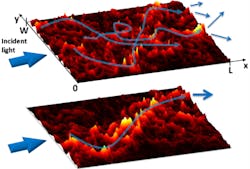Optical absorption straightens the path of light in diffusing materials
In a study partly funded by the Foundation for Fundamental Research on Matter (FOM Foundation; Utrecht, The Netherlands), physicists from the University of Twente (Enschede, The Netherlands) and Yale University (New Haven, CT) have discovered that light traveling through a diffusing material follows a straighter path if the material partially absorbs the light.1 This insight could be used to improve medical imaging within biological tissue, for example.
Photons traveling through a scattering medium perform a so-called random walk, which resembles an uncoordinated stagger through the material. The Dutch-American team of researchers has discovered that in opaque media, such as paper, paint or biological tissue, light absorption actually straightens this path, leading to less diffraction by scattering and thus improved imaging through the material. This seems counterintuitive: light absorption is usually detrimental for imaging, as it reduces the intensity of the visible image.
The researchers discovered that if enough light is absorbed, interference is suppressed; a numerical calculations showed that long, meandering light paths are suppressed far more than short straight paths. The result is that with increasing absorption, the straight ("ballistic") light paths persist while the number of scattered paths is considerably reduced.
Applicable to LED lighting
The results could also help the lighting industry. "Our new insights can be used to achieve much more efficient color conversion in white LEDs," says University of Twente researcher Willem Vos. "This reduces the need for precious resources such as rare-earth compounds."
The research was supported by the US National Science Foundation, the European Research Council, the Netherlands Organisation for Scientific Research (NWO), FOM, and Technology Foundation STW.
Source: http://www.fom.nl/live/english/news/archives/pressreleases2014/artikel.pag?objectnumber=268094
REFERENCE:
1. Seng Fatt Liew et al., Physical Review B, Vol. 89, Issue 25, 1 July 2014; doi: 10.1103/PhysRevB.89.224202

John Wallace | Senior Technical Editor (1998-2022)
John Wallace was with Laser Focus World for nearly 25 years, retiring in late June 2022. He obtained a bachelor's degree in mechanical engineering and physics at Rutgers University and a master's in optical engineering at the University of Rochester. Before becoming an editor, John worked as an engineer at RCA, Exxon, Eastman Kodak, and GCA Corporation.
